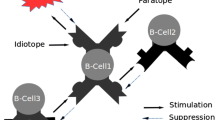Abstract
A table-look-up immune network is proposed to solve problems arising from autonomous microrobots trying to achieve a given goal with limited memory and calculation capacity. The method is implemented and tested with a microrobot “Kity”, with a size of less than 1 cubic inch. It is possible to generate enough rules to make the robot achieve the goal of navigating freely in a maze with a small number of sensors. Experimental results show the efficacy of immune networks in controling robots in restricted environments. Kity demonstrated the efficiency of the associated algorithm arrived at by winning first prize at the 4th and 5th International Microrobot Maze Contests held in Nagoya, Japan, in October, 1995 and 1996.
Similar content being viewed by others
References
Farmer JD, Packard NH (1986) The immune system, adaptation, and machine learning, Physica 22D:187–204
Ishiguro A, Kondo T, Watanabe Y, Uchikawa Y (1995) An immunological approach to dynamic behavior control for autonomous mobile robots. IEEE Conference, IROS, pp. 495–500
Jerne NK (1984) Idiotypic networks and other preconceived ideas. Immunol Rev 79:5–24
Author information
Authors and Affiliations
Corresponding author
About this article
Cite this article
Kim, JH., Jung, MJ., Shim, HS. et al. Autonomous micro-robot “Kity” for maze contest. Artificial Life and Robotics 1, 137–140 (1997). https://doi.org/10.1007/BF02471128
Received:
Accepted:
Issue Date:
DOI: https://doi.org/10.1007/BF02471128




